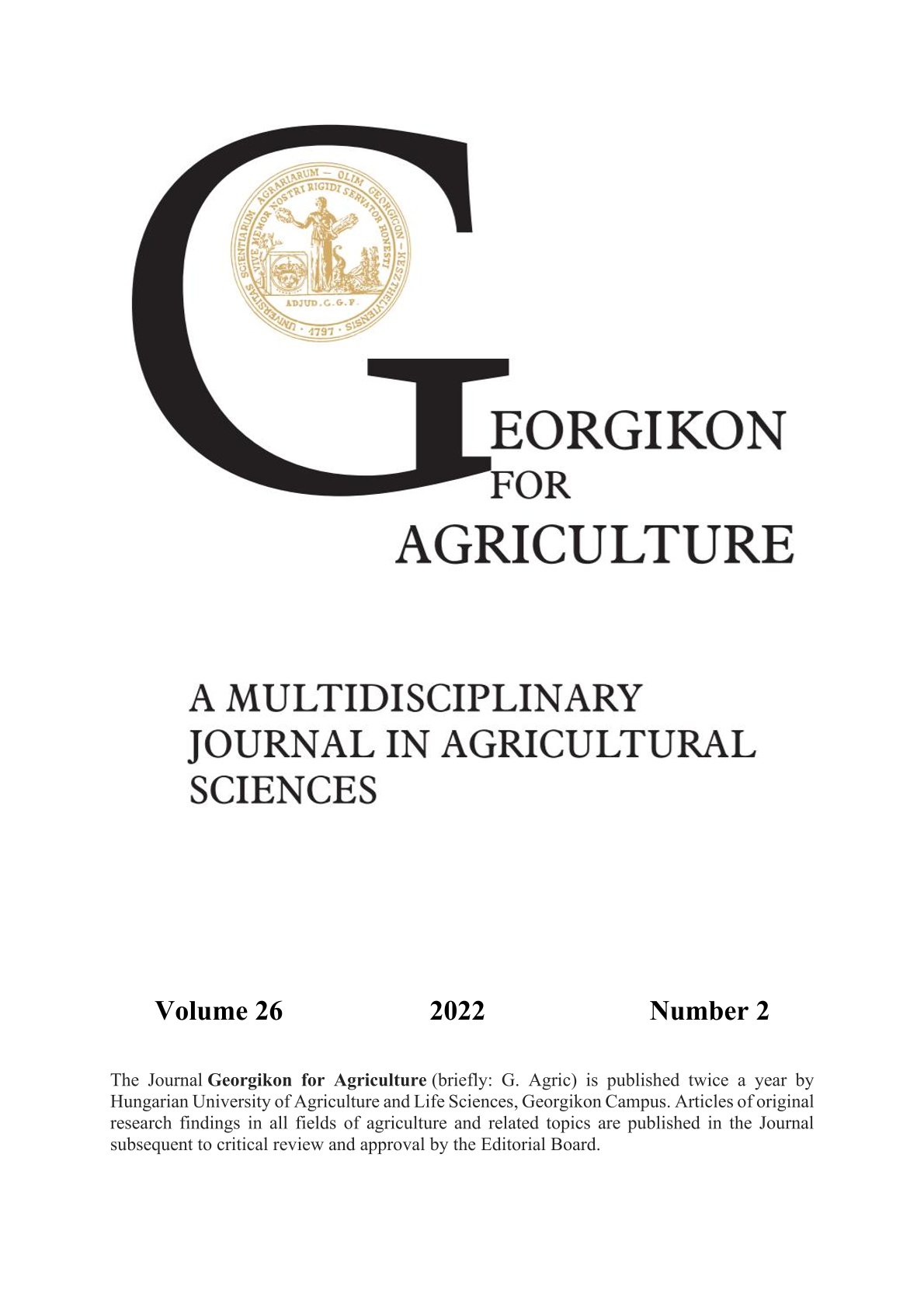Comparison of Class A pan evaporation with estimated reference evaporation and evapotranspiration
Keywords:
evaporation, class A pan, floating leaf macrophyteAbstract
Aquatic plants (macrophytes) can have a large effect on water evaporation, yet they are ignored when determining evaporation from lakes and reservoirs. The aim of the experiment was to determine the effect of a floating leaf macrophyte (Nuphar lutea, yellow water lily) on evaporation. The measured evaporation data were also compared with the calculated from the evaporation/evapotranspiration formulas used in the literature (Shuttleworth, FAO56 Penman-Monteith, Hargreaves-Samani and Priestley-Taylor formula). The results showed that the presence of yellow water lily increase Class A pan evaporation. Of the empirical formulas, the FAO-56 Penman-Monteith reference evapotranspiration values were closest to the observed evaporation values.
References
Allen, R., Pereira, L., Raes, D. and Smith, M. 1998. Crop evapotranspiration: Guidelines for computing crop requirements. Irrigation and Drainage Paper No. 56, FAO, Rome, Italy.
Anda, A. Simon, B., Soós, G., Menyhárt, L., Teixeira, da Silva J.A. and Kucserka, T. 2018. Extending Class A pan evaporation for a shallow lake to simulate the impact of littoral sediment and submerged macrophytes: a case study for Keszthely Bay (Lake Balaton, Hungary). Agricultural and Forest Meteorology. 250–251. 277–289. https://doi.org/10.1016/j.agrformet.2018.01.001
Bal, K., Bouma, T.J., Buis, K., Struyf, E., Schoelynck, J., Backx, H. and Meire, P. 2011. Trade-off between drag reduction and light interception of macrophytes: comparing five aquatic plants with contrasting morphology. Functional Ecology. 25(6). 1197–1205. https://doi.org/10.1111/j.1365-2435.2011.01909.x
Brezny, O., Mehta, I. and Sharmas, R.K. 1973. Studies of evapotranspiration of some aquatic weeds. Weed Science. 21(3). 197–204. https://doi.org/10.1017/S0043174500032112
Crop evapotranspiration-Guidelines for computing crop water requirements-FAO Irrigation and drainage paper 56. FAO, Rome 300 (9), D05109.
Doorenbos, J. and Pruitt, W. 1977. Guidelines for predicting crop water requirements. Irrig. Drain. Paper, 24. FAO, Rome, Italy.
Hargreaves, G. and Samani, Z. 1985. Reference crop evapotranspiration from temperature. Applied Engineering in Agriculture. 1(2). 96–99. https://doi.org/10.13031/2013.26773.
Heslop-Harrison, Y. 1955. Nuphar Sm. Biological flora of the British Isles. Journal of Ecology. 43(1). 342–364. https://doi.org/10.2307/2257147.
Monteith, J.L. and Unsworth, M.H. 1990. Principles of environmental physics, 2nd edn. Edward Arnold: London; 291 pp.
Penman, H.L. 1948. Natural evaporation from open water, bare soil and grass. Proceeding Royal Society A. 193(1032). 120–145. https://doi.org/10.1098/rspa.1948.0037.
Priestley, C.H.B. and Taylor, R.T. 1972. On the assessment of surface heat flux and evaporation using large scale parameters. Monthly Weather Review. 100(2). 81–92. https://doi.org/10.1175/1520-0493(1972)100<0081:OTAOSH>2.3.CO;2.
El-Din, S.M.B. and Abdel-Aziz, R.A. 2018. Potential uses of aquatic plants for wastewater treatment. Journal of Experimental and Clinical Microbiology. 2(2). 47–48. Agricultural Microbiology Department, Agricultural and Biological Research. Division, National Research Centre, Dokki, Cairo, Egypt.
Samani, Z. 2000. Estimating solar radiation and evapotranspiration using minimum climatological data. Journal of Irrigation and Drainage Engineering. 126(4). 265–267. https://doi.org/10.1061/(ASCE)0733-9437(2000)126:4(265).
Schoelynck, J., Bal, K., Verschoren, V., Penning, E., Struyf, E., Bouma, T., Meire, D., Meire, P. and Temmerman, S. 2014. Different morphology of Nuphar lutea in two contrasting aquatic environments and its effect on ecosystem engineering. Earth Surface Processes and Landforms. 39(15). 2100–2108. https://doi.org/10.1002/esp.3607.
Shuttleworth, W.J. 1992. Chapter 4 evaporation. In: Maidment, D.R. (Ed.), Handbook of Hydrology. McGraw-Hill Inc., New York.
Snyder, R. and Boyd, C. 1987. Evapotranspiration by Eichhornia crassipes (Mart.) Solms and Typha latifolia L. Aquatic Botany. 27(3). 217–227.
Soloviy, K. and Malovanyy, M. 2019. Freshwater ecosystem macrophytes and microphytes: development, environmental problems, usage as raw material. Review. Environmental Problems. 4(3). 115–124. https://doi.org/10.23939/ep2019.03.115.
Stanhill, G. 2002. Is the class A evaporation pan still the most practical and accurate meteorological method for determining irrigation water requirements? Agricultural and Forest Meteorology. 112(3). 233–236. https://doi.org/10.1016/S0168-1923(02)00132-6.
Thornthwaite, C.W. 1948. An Approach toward a Rational Classification of Climate. Geographical Review. 38(1). 55–94. https://doi.org/10.2307/210739.
Waheeb Youssef, Y. and Khodzinskaya, A. 2019. A Review of Evaporation Reduction Мethods from Water Surfaces. E3S Web of Conferences. 97. 05044.
Xiang, K., Li, Y., Horton, R. and Feng, H. 2020. Similarity and difference of potential evapotranspiration and reference crop evapotranspiration – a review. Agricultural Water Management. 232. 106043. https://doi.org/10.1016/j.agwat.2020.106043
Downloads
Published
Issue
Section
License
Copyright (c) 2022 Simon-Gáspár Brigitta, Soós Gábor, Anda Angéla

This work is licensed under a Creative Commons Attribution-NonCommercial-NoDerivatives 4.0 International License.
Cikkre a Creative Commons 4.0 standard licenc alábbi típusa vonatkozik: CC-BY-NC-ND-4.0. Ennek értelmében a mű szabadon másolható, terjeszthető, bemutatható és előadható, azonban nem használható fel kereskedelmi célokra (NC), továbbá nem módosítható és nem készíthető belőle átdolgozás, származékos mű (ND). A licenc alapján a szerző vagy a jogosult által meghatározott módon fel kell tüntetni a szerző nevét és a szerzői mű címét (BY).




